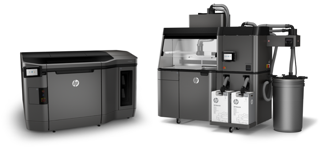
Until now, the language of 3D printing has been lacking in three noteworthy terms: high productivity, low cost of parts, and reliable quality.
 With HP’s development of HP Multi Jet Fusion technology and the new HP Jet Fusion 3D printers, the industry vocabulary is expanding – and a new era of manufacturing is under way.
With HP’s development of HP Multi Jet Fusion technology and the new HP Jet Fusion 3D printers, the industry vocabulary is expanding – and a new era of manufacturing is under way.
HP’s Jet Fusion 3D 3200/4200 printers represent long-awaited progress in speed, quality, and economics. And the revolutionary HP Open Platform approach to materials development is driving broader adoption of 3D printing.
This compelling new dimension in 3D printing has its origins in HP’s legacy of investment in inkjet printing, jettable materials, precision low-cost mechanics, material science, and imaging. Drawing on this foundation, the key innovation in HP Multi Jet Fusion is a high-speed, synchronous architecture. And the result? The capacity to separate the processes of recoating and printing/fusing during the printing stage – making it possible for each process to be separately optimized for performance, reliability and productivity.
With the resulting breakthrough, HP Jet Fusion 3D printers are delivering high build quality 1 at up to 10 times the speed 2 of traditional 3D printers, and at the lowest cost 3 relative to competitive 3D printing solutions in the marketplace today.
 Another leap forward that HP has made in 3D printing technology is the capability of controlling properties – including color in the future – for individual voxels. By specifying the properties of each voxel, you can define your 3D-printed part point by point over the surface and within the volume.
Another leap forward that HP has made in 3D printing technology is the capability of controlling properties – including color in the future – for individual voxels. By specifying the properties of each voxel, you can define your 3D-printed part point by point over the surface and within the volume.
Additionally, HP’s advancements in the development of 3D printing materials are opening opportunities for designers to work with a growing range of materials. Not only is HP developing a family of thermoplastics for future generations of HP 3D printers, the HP Open Platform is enabling partners such as Arkema, BASF, Evonik and others to develop new materials for Jet Fusion 3D printers. By driving toward an open-materials marketplace, HP and its partners are accelerating the adoption of HP Multi Jet Fusion technology across industries and applications.
You can look for the full story on HP’s innovations with Multi Jet Fusion technology, including with design and production software, in the technical white paper “HP Multi Jet Fusion technology: A disruptive 3D printing technology for a new era of manufacturing.” As you’ll see, manufacturing will soon be speaking a whole new language. Discuss in the HP forum at 3DPB.com.
1 Based on dimensional accuracy of ±0.2 mm/0.008 inches measured after sand blasting and with the following mechanical properties: Tensile strength at 45-50 MPa (XYZ), Modulus 1600-1900 MPa (XYZ). ASTM standard tests with PA12 material. See hp.com/go/3Dmaterials for more information. Based on the following mechanical properties: Tensile strength at 50, Modulus Z 1900, Modulus XY 1900. ASTM standard tests with HP 3D High Reusability PA 12 material.
2 Based on internal testing and simulation, HP Jet Fusion 3D printing solution average printing time is up to 10x faster than average printing time of comparable FDM & SLS printer solutions from $100,000 USD to $300,000 USD on market as of April 2016. Testing variables: Part Quantity -1 full bucket of parts from HP Jet Fusion 3D at 20% of packing density vs same number of parts on above-mentioned competitive devices; Part size: 30g; Layer thickness: 0.1mm/0.004 inches.
Fast Cooling is enabled by HP Jet Fusion 3D Processing Station with Fast Cooling, available in 2017. HP Jet Fusion 3D Processing Station with Fast Cooling accelerates parts cooling time vs recommended manufacturer time of SLS printer solutions from $100,000 USD to $300,000 USD, as tested in April 2016. FDM not applicable.
3 Based on internal testing and public data, HP Jet Fusion 3D printing solution average printing cost-per-part is half the average cost of comparable FDM & SLS printer solutions from $100,000 USD to $300,000 USD on market as of April 2016. Cost analysis based on: standard solution configuration price, supplies price, and maintenance costs recommended by manufacturer. Cost criteria: printing 1-2 build chambers per day/ 5 days per week over 1 year of 30-gram parts at 10% packing density using HP 3D High Reusability PA 12 material, and the powder reusability ratio recommended by manufacturer.
Subscribe to Our Email Newsletter
Stay up-to-date on all the latest news from the 3D printing industry and receive information and offers from third party vendors.
You May Also Like
3D Printing News Unpeeled: A $3000 SLS System, Construction Subsidies and Parameters
The Housing Affordability Crisis is one of Canadian President Trudeau’s biggest issues. Now the government has made subsidies available, including scaling new technologies, 3D printed housing and libraries of reapproved...
“Bundled Light” Enables High Quality Plastic 3D Printing from LEAM
Naturally, we expect current 3D printing methods to continuously improve, but it continues to do so in the most surprising ways. The latest development comes from LEAM, a startup spun...
Each to Their Own: Exploring Creality’s Latest Ender Trio as the Company Strengthens Its Commitment to 3D Printing Advocacy
Creality has reaffirmed its commitment to promoting 3D printing. The launch of the Ender-3 V3 SE, Ender-3 V3 KE, and Ender-3 V3 showcases the company’s dedication to catering to diverse...
3D Printing News Briefs, March 23, 2024: AM in the US Coast Guard, Navy, & More
In today’s 3D Printing News Briefs, we’re discussing the use of 3D printing in various branches of the military, including the U.S. Coast Guard, the U.S. Navy, and the German...
































